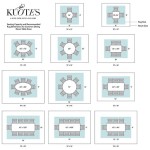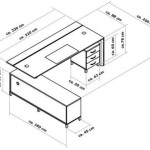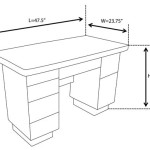What Is Standard Table Height?
The standard table height is a commonly accepted measurement that promotes comfort, ergonomics, and practicality in various settings. It is a guideline that ensures tables are at a suitable height for different activities, from dining to working to studying. Understanding the standard table height is crucial for anyone engaged in designing, furnishing, or using tables in homes, offices, schools, and public spaces.
Table Height Standards for Dining Tables
Dining tables play a pivotal role in social gatherings, meals, and family bonding. They are designed to accommodate comfortable seating and facilitate enjoyable dining experiences. The standard height for dining tables is typically 28 to 30 inches (71 to 76 cm) from the floor to the tabletop. This height allows for proper posture, prevents strain on the back and neck, and enables easy reaching for food and drinks.
It is important to note that table height can vary depending on the chair height. The ideal dining setup involves a table height that allows for a 10-inch (25 cm) gap between the seat of the chair and the underside of the table. This gap provides sufficient legroom and prevents discomfort during prolonged seating.
Table Height Standards for Work and Study Tables
Work and study tables require a different height compared to dining tables to promote optimal ergonomics and productivity. The standard height for these tables is typically 29 to 30 inches (74 to 76 cm) from the floor to the tabletop. This height allows for comfortable typing, writing, and reading without straining the wrists, neck, or back.
Ergonomic considerations are vital for work and study tables. The table height should be adjusted to ensure that the elbows are bent at a 90-degree angle when seated. The wrists should be in a neutral position, and the keyboard and mouse should be within easy reach. This positioning helps prevent repetitive strain injuries and promotes a healthy posture.
Table Height Standards for Other Table Types
Besides dining and work/study tables, other types of tables have their own standard heights: *
Coffee Tables:
18 to 21 inches (46 to 53 cm) *End Tables:
24 to 28 inches (61 to 71 cm) *Console Tables:
30 to 36 inches (76 to 91 cm) *Bar Tables:
42 inches (107 cm) *Standing Desks:
36 to 44 inches (91 to 112 cm)These heights are determined by the intended use and the user's comfort. For example, coffee tables are designed to be lower for easy access to beverages and snacks. Console tables, often used in hallways, are typically higher for display purposes.
Factors Affecting Table Height Standards
Several factors can influence the standard table height, including:
- User Height: Tall individuals may prefer higher tables, while shorter individuals may find lower tables more comfortable.
- Cultural Preferences: Different cultures may have different preferences for table heights. For example, traditional Japanese dining tables are often much lower than Western dining tables.
- Architectural Considerations: Room dimensions, ceiling height, and furniture placement can all affect table height choices.
- Intended Use: The specific activity or function for which the table is designed can influence its optimal height.
The standard table height is a helpful guide, but it is important to consider individual factors and preferences when selecting or designing tables. By understanding the principles behind standard table heights, individuals can create comfortable, ergonomic, and functional spaces.

What Are Standard Table Heights

What Are Standard Table Heights

What Is The Ideal Dining Table And Chair Height

Standard Dining Table Dimensions Sizes With 9 Detailed Diagrams Homenish Height

Dining Table Height Chair

How To Pick The Right Dining Chair Height Inside

What Is The Ideal Dining Table And Chair Height

What Is The Ideal Dining Table And Chair Height

Redress

How To Pick A Table Guide Including Dimensions








